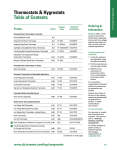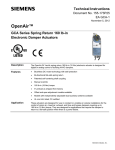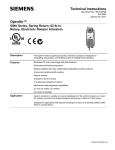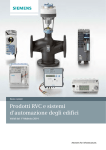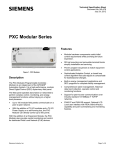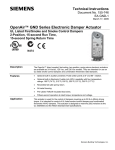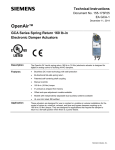Download Siemens LB 75 Series Specifications
Transcript
Technical Instructions Document No. 155-176P25 EA GBB/GIB-1 December 15, 2004 OpenAir™ GBB/GIB Series Electronic Damper Actuators NSR Rotary, 24 Vac - Modulating Control Description The OpenAir direct coupled 24 Vac non-spring return (NSR) rotary electric actuator is designed for modulating control of building HVAC dampers. Features • Built-in feedback on modulating units • Unique self-centering shaft coupling • All metal housing • Two torque ranges available • Manual override • Offset and span adjustment models available • Independently adjustable dual auxiliary switches available • UL, cUL and CE listed Product Numbers Table 1. 24 Vac Operating Voltage Torque 221 lb-in (25 Nm) 310 lb-in (35 Nm) Application Input Signal Cabling Standard Span/Offset Adjustable Dual Auxiliary Switches and Span/Offset Adjustable Dual Auxiliary Switches only 0 to 10 Vdc Standard GBB161.1U Plenum Cable GBB161.1P GBB163.1U GBB163.1P GBB164.1U GBB164.1P GBB166.1U GBB166.1P 0 to 10 Vdc Standard Plenum Cable GIB163.1U GIB163.1P GIB164.1U GIB164.1P GIB166.1U GIB166.1P GIB161.1U GIB161.1P These actuators are used in constant or variable air volume installations for the control of supply return air, mixed air, exhaust, rooftop units, and face and bypass dampers requiring up to 221 lb-in (25 Nm) torque or 310 lb-in (35 Nm) torque. Siemens Building Technologies, Inc. Technical Instructions Document Number 155-176P25 December 15, 2004 GBB/GIB Series NSR Rotary 24 Vac - Modulating Control Warning/Caution Notations WARNING: Personal injury/loss of life may occur if you do perform a as specified. CAUTION: Specifications Power supply Control Signal Feedback Signal Equipment Rating Auxiliary Features Equipment damage or loss of data may occur if you do not follow a procedure as specified. Operating voltage (G–G0) Frequency Power consumption Running… Holding… 24 Vac ±20% 50/60 Hz 8 VA, 8W 1.1W For one tandem application 12 VA of two actuators Input signal (Y–G0) voltage-input 0 to 10 Vdc Input resistance >100K ohms Position output signal (U–G0) Voltage-output 0 to 10 Vdc Maximum output current DC 1 mA Operating voltage, input signal and Class 2, in accordance with UL/CSA position output signal Plenum type actuators as a whole device Class 2 in accordance with UL/CSA Dual auxiliary switches AC rating (standard cable) AC rating (Plenum cable) DC rating (Standard/Plenum cable) 24 to 250 Vac AC 6A resistive AC 2A general purpose 24 Vac AC 4A resistive AC 2A general purpose 12 to 30 Vdc DC 2A Switch Range Switch A Recommended range usage Factory setting Switch B Recommended range usage Factory setting 0 to 90° with 5° intervals 0 to 45° 5° 0 to 90° with 5° intervals 45 to 90° 85° Switching hysteresis 2° WARNING: Apply only AC-line voltage from the same phase or only UL-Class 2 voltage (SELV for CE conformance) to the switching outputs of both auxiliary switches A and B. Mixed operation is not permissible. NOTE: Page 2 With plenum cables, only UL-Class 2 voltage (SELV for CE is permissible). Siemens Building Technologies, Inc. GBB/GIB Series NSR Rotary 24 Vac - Modulating Control Function Torque GBB… GIB… Runtime for 90° opening or closing Mounting Nominal angle of rotation Maximum angular rotation Noise level Shaft size Housing Minimum shaft length Enclosure Specifications, Continued Ambient Conditions Material Gear lubrication Ambient temperature Operation Storage and transport Ambient humidity (non-condensing) Agency Approvals Technical Instructions Document Number 155-176P25 December 15, 2004 221 lb-in (25 Nm) 310 lb-in (35 Nm) 125 seconds at 60 Hz 150 seconds at 50 Hz 90° 95° <45 dBA 3/8 to 1-inch (8 to 25.6 mm) diameter 1/4 to 5/8-inch (6 to 18 mm) square 3/4-inches (20 mm) NEMA 2 in vertical position to 90° to the left and right of vertical See Figure 17 NEMA 3R rated when installed with ASK75.1U Weather Shield in the vertical position. See Accessories. IP54 according to EN60529 Die cast aluminum alloy Silicone-free -25°F to 130°F (-32°C to 55°C) -40°F to 158°F (-40°C to 70°C) 95% rh UL listed to UL873 cUL certified to Canadian Standard C22.2 No. 24-93 CE conformity: Electromagnetic compatibility 89/336/EEC Low-voltage directive 73/23/EEC Miscellaneous Pre-cabled connection Cable length Life cycle Dimensions Weight Siemens Building Technologies, Inc. 18 AWG 3 feet (0.9m) Designed for over 60,000 full strokes and a minimum of 1.5 million repositions at rated torque and temperature See Figure 28 4.4 lbs (2 kg) Page 3 Technical Instructions Document Number 155-176P25 December 15, 2004 Accessories GBB/GIB Series NSR Rotary 24 Vac - Modulating Control NOTE: Neither the control signal adjustments nor the auxiliary switches can be added in the field. Order the product numbers that include these options. EA0477R2 ASK71.1U: Kit allows foot mounting of the OpenAir actuators. Kit should be used for in-the-air stream applications, and anywhere a foot-mounted actuator can be mounted. Kit contains: (4 each) Figure 1. Floor Mount Kit. • Crank arm that changes the angular rotation into a linear stroke • Support bearing ring to minimize side loading on the actuator’s output bearing • Mounting bracket • Required mounting fasteners EA0476R2 ASK71.2U: Kit allows mounting of OpenAir actuators directly to a damper frame. Kit should be used with louvers and vents and in applications where use of the floor mount kit is not possible. EA0495R1 Figure 2. Frame Mount Kit. EA0494R1 Figure 3. Crank Arm Kit. Figure 4. Crank Arm Kit with Mounting Bracket. Page 4 Kit contains: • Crank arm that changes the angular rotation into a linear stroke • Support bearing ring to minimize side loading on the actuator’s output bearing • Mounting bracket • Required mounting fasteners ASK71.3: Kit allows a direct-coupled actuator to provide an auxiliary linear drive. Crank arm kit can be used to simultaneously drive a set of opposing or adjacent dampers with a single actuator. Kit contains: • Crank arm that attaches to the splined hub of the shaft adapter • Other required mounting fasteners ASK71.4: Kit allows economical mounting of OpenAir actuators to a variety of surfaces. Kit should be used in applications where the actuator can be rigidly surface mounted and a linear stroke output is required. Kit contains: • Crank arm that attaches to the splined hub of the shaft adapter • Mounting bracket • Required mounting fasteners Siemens Building Technologies, Inc. GBB/GIB Series NSR Rotary 24 Vac - Modulating Control Technical Instructions Document Number 155-176P25 December 15, 2004 ASK73.1U: Provides an extended antirotation pin that allows two modulating GIB actuators to directly drive a single damper shaft. For any combination of GIB161x and GIB166x actuators. Accessories, EA0496R1 Continued EA0497R1 Figure 5. Tandem Mounting Bracket. Figure 6. Special Shaft Adapter. Bracket must be ordered for tandem installation. ASK74.1U: Shaft adapter attaches to a 1.05-inch (26.6 mm) diameter shaft; whereas, the standard self-centering adapter accepts up to a 1.00-inch (25 mm) diameter shaft. This special adapter can be used for coupling to 1-inch jackshafts that are slightly oversized. Shaft adapter is 13/16-inches (20 mm) shorter than the height of the self-centering shaft adapter. 985-052P20: Small shaft insert (package of 20) when using the GIB actuator on a damper shaft less than 3/4-inch (20 mm) diameter. EA0845R1 ASK75.1U: The GBB/GIB actuators are UL listed to meet NEMA 3R requirements (a degree of protection against rain, sleet, and damage from external ice formation) when installed with this ASK75.1U weather shield and outdoor-rated conduit fittings in the vertical position. (14) Figure 7. Weather Shield. EA0992R1 Heating Element For dimensions, see Figure 27. 985-106: Provides protection for GIB, GBB and GCA OpenAir actuators in an outside low temperature. Assembly includes: • Weather Shield (ASK75.1U) • Heater Kit (985-105)S Thermostat Figure 8. Heater/Weather Shield Assembly. EA1059R1 985-008: 1/2-inch (12 mm) for 1/2-inch NPT connector. Figure 9. Conduit Adapter. Siemens Building Technologies, Inc. Page 5 Technical Instructions Document Number 155-176P25 December 15, 2004 GBB/GIB Series NSR Rotary 24 Vac - Modulating Control EA0499R1 EA0498R1 EA0500R1 Service Parts Figure 10. Position Indicator. 985-003 (package of 10) Figure 11. Standard Shaft Adapter. 985-004 Actuator Components Figure 12. Anti-rotation (Mounting) Bracket. 985-006 Legend 10 9 1 1. Positioning scale for angle of rotation 90 2. Span adjustment A B PUSH 11 3. Offset (start point) adjustment 8 7 6 4. Direction of rotation arrow 5. Connection cables 12 6. Manual override Span, DU 2 10 2 16 30 24 EA0375R1 3 4 7. Auxiliary switch B Offset, Uo 0 1 2 3 5 8. Auxiliary switch A 4 9. Position indicator 13 10. Self-centering shaft adapter EA1150R1 5 Figure 13. Components of the Modulating Actuator. Page 6 11. Shaft adapter locking clip 12. Position indicator adapter 13. Mounting bracket Siemens Building Technologies, Inc. GBB/GIB Series NSR Rotary 24 Vac - Modulating Control Operation Technical Instructions Document Number 155-176P25 December 15, 2004 A continuous 0 to 10 Vdc signal from a controller to wire Y operates the damper actuator. The angle of rotation is proportional to the control signal. A 0 to 10 Vdc position feedback output signal is available between wires U and G0 (system neutral) to monitor the position of the damper motor. In the event of a power failure, depending on load, the actuator may not hold the commanded (or new) position. In the event only the control signal is lost, the actuator returns to the "0" position. In the event of a blockage in the damper, the actuator is overload protected over the full range to prevent damage to the actuator. Life Expectancy An improperly tuned loop will cause excessive repositioning that will shorten the life of the actuator. Control Signal Adjustment GBB/GIB 163x GBB/GIB 164x The offset (start point) and span of the control signal can be adjusted. The offset point, U0, (start point) can be adjusted between 0 to 5 Vdc. The span, ∆U, can be adjusted between 2 to 30 Vdc. YS (%) 100 1) 3) 2) Control Signals 2 Span, U 10 16 Ys Yu U0 ∆U 24 2 5 UO 10 35 YU (v) Offset, Uo 1 0 2 ∆U (max. 30 V) 3 Mechanical positioning range (100% = angle of rotation 90°) Control signal Offset (start point) Span 1. Uo =0V, ∆U = 2V Minimum working range for Ys = 100% 2. Uo = 5V, ∆U = 30V Maximum working range for Ys = 100% 3. Uo = 0V, ∆U ≈ 10V Factory setting 5 Uo 4 U EA0544R1 EA0411R1 30 0 Setting for 10V span 0 offset Figure 14. Minimum, Factory Setting, and Maximum Control Signal Adjustment. Siemens Building Technologies, Inc. Page 7 Technical Instructions Document Number 155-176P25 December 15, 2004 GBB/GIB Series NSR Rotary 24 Vac - Modulating Control Operation, Continued Open the actuator from 0% to 50% (45°) using a control signal of Umin = 2V to Umax= 10V. Control Signal Adjustment Example ∆U = Calculating the value of ∆U: 100 [%] x (U max − U min) Working angle of rotation [%] Settings: = 100% x (10V - 2V) 50% = 16 V YS (%) 100 Uo = 2V; ∆U = 16V 50 Umin = minimum control signal Umax = maximum control signal 0 EA0412R1 2 Uo Umin 10 18 YU (v) ∆U (16 V) Umax Figure 15. Example. Dual Auxiliary Switch GBB/GIB 164x, and GBB/GIB 166x -2,5 0 10 20 30 70 80 A EA0640R1 0 92,5 90 90 92,5 B 10 20 30 70 80 80 70 60 20 10 90 0 -2,5 Actuator Scale: clockwise Adjustment range for Switches A and B Setting interval: 5° Switching hysteresis: 2° Actuator Scale: counterclockwise NOTE: The auxiliary switch setting shafts turn together with the actuator. The scales are valid only when the actuator is in the "0" position on clockwise motion. To change the settings of A and B, use a flat-blade screwdriver to turn the switch adjustment dials to the desired setting at which a signal is to be given. A AUX 40 SWITCH 20 ADJ 30 Factory setting 5° 85° 40 10 70 90 80 50 60 70 EA0304R1 B Switch A Switch B 20 Figure 16. Dual Auxiliary Switch Dials. Page 8 Siemens Building Technologies, Inc. GBB/GIB Series NSR Rotary 24 Vac - Modulating Control Sizing Technical Instructions Document Number 155-176P25 December 15, 2004 The number of actuators required depends on several factors. To determine the quantity of actuators required for the installation, do the following: 1. Obtain damper torque ratings (ft-lb/ft2 or Nm/m2) from the damper manufacturer. 2. Determine the area of the damper. 3. Calculate the total torque required to move the damper: Total Torque = Torque Rating × Damper Area 4. Select the total quantity of actuators required: Number of actuators = Total Damper Torque required 1 SF x Actuator Torque (Refer to Specifications) 1 Safety Factor: When calculating the number of actuators required, a safety factor should be included for unaccountable variables such as slight misalignments, aging of the damper, etc. A suggested safety factor is 0.80 (or 80% of the rated torque). Mounting and Installation <9 0˚ NEMA 2 < 90 90 ˚ ˚ EA1152R1 EA1104R1 NEMA 2 Figure 17. Acceptable NEMA 2 Positions. 0 < 90 90 Figure 18. Acceptable NEMA 2 Position for Tandem Applications. The direction of rotation switch must be set to match the clockwise or counterclockwise rotation of the damper shaft. The factory setting is clockwise. See Figure 13 for location on the actuator. EA0320R2 • <9 CLOCKWISE COUNTER CLOCKWISE Figure 19. Direction of Rotation Switch. • The minimum damper drive shaft length is 3/4-inches (20 mm). The shaft length determines whether the shaft adapter will be mounted on the front or back side of the actuator. • See Specifications for minimum and maximum damper shaft dimensions. • The shaft adapter can be mounted on either side of the actuator. The direction of rotation and shaft length determine how the shaft adapter will be mounted on the actuator. • The position indicator can be mounted to show either the clockwise or counterclockwise 0 to 90 scale. • The actuator is shipped from the factory with a 5° pre-load to ensure tight close off of the damper. • The shaft adapter and mounting parts are shipped in a separate container with the actuator. • Detailed mounting instructions are included with each actuator. Siemens Building Technologies, Inc. Page 9 Technical Instructions Document Number 155-176P25 December 15, 2004 GBB/GIB Series NSR Rotary 24 Vac - Modulating Control Mounting and Installation, continued • The direction of rotation switches must be set identically on both actuators according to the clockwise or counterclockwise rotation of the damper shaft. The factory setting is clockwise. See Figure 13 for location on the actuators. • The tandem actuator pair is intended for use on the same mechanical load. • Minimum damper drive shaft length is 4-inches (100 mm). Tandem Applications CAUTION: No more than three actuators are to be used in tandem applications. Manual override To move the damper blades when power is not present: 3 1. Hold down the PUSH button. 2. Make adjustments to the damper position. 3 3. Release the PUSH button. If there is no load, the actuator will hold the new damper position. If load conditions exist, the actuator might not be able to hold. 2 SH PU SH PU PUSH EA0360R1 NOTE: 2 PUSH 1 L > 3 in. 77mm L < 3 in. 77mm Figure 20. Manual Override. Once power is restored, the actuator returns to automated control. Mechanical Range Adjustment The angular rotation is adjustable between 0 and 90° at 5-degree intervals. The range of shaft movement is limited by mounting the shaft adapter: 1 2 1. Loosen the shaft adapter from the damper shaft and remove the actuator from the damper shaft. SH EA0305R2 PU Figure 21. 2. Remove the clip and shaft adapter from the actuator. 90 90 90 90 90 90 PUSH PUSH Figure 22. Page 10 EA0650R1 EA0649R1 EA0648R1 PUSH Figure 23. Figure 24. Siemens Building Technologies, Inc. GBB/GIB Series NSR Rotary 24 Vac - Modulating Control Mechanical Range Adjustment, Continued Technical Instructions Document Number 155-176P25 December 15, 2004 3. Return the actuator gear train to the "0" position using the steps that follow for the clockwise or counterclockwise damper shaft rotation. Clockwise-to-open: a. Insert the shaft adapter to the right as close as possible to the raised stop. See Figure 22. b. Hold down the PUSH button and rotate the shaft adapter to the left until it stops. See Figure 23. c. Release the PUSH button. d. If the shaft adapter is not resting against the left raised stop, remove the adapter and insert it against the left stop. e. Place the position indicator to the "0" position on the outside scale. See Figure 24. Counterclockwise-to-open: a. Insert the shaft adapter to the left as close as possible to the raised stop. b. Hold down the PUSH button and rotate the shaft adapter to the right until it stops. c. Release the PUSH button. d. If the shaft adapter is not resting against the right raised stop, remove the adapter and insert it against the right stop. e. Place the position indicator to "0" on the inside scale. 4. Determine the angle of rotation for the damper blade shaft. Subtract that amount from 90°. 5. Remove the shaft adapter and insert it with the position indicator pointing to mark on the scale calculated in the previous step. See Figure 25. 6. Attach the clip. 7. Rotate the damper blade shaft to its "0" position. 8. Return the actuator to the damper shaft and tighten the shaft adapter to the damper shaft. ANGL E OF RO TA T N IO 90 90 EA0651R1 PUSH Figure 25. Mechanical Range Adjustment. Siemens Building Technologies, Inc. Page 11 Technical Instructions Document Number 155-176P25 December 15, 2004 Reversing the Position Indicator GBB/GIB Series NSR Rotary 24 Vac - Modulating Control Reverse the position indicator so that the counterclockwise 0 to 90 scale is visible. See Figure 26. POSITION INDICATOR 1 2 3 SH SH PU EA0551R2 PU Figure 26. Position Indicator. Wiring All wiring must conform to NEC and local codes and regulations. Use earth ground isolating step-down Class 2 transformers. Do not use autotransformers. The maximum rating for a Class 2 step-down transformer is 100 VA. Determine the supply transformer rating by summing the VA ratings of all actuators and all other components used. It is recommended that one transformer power no more than 10 actuators (or 80% of its VA). WARNINGS: • Mixed switch operation is not permitted to the switching outputs of both auxiliary switches (A and B). • Either AC line voltage from the same phase must be applied to all six outputs of the dual auxiliary switches, or UL-Class 2 voltage must be applied to all six output. NOTE: With plenum cables, only UL-Class 2 voltage is permitted. CAUTION: Do not parallel wire GBB/GIB with any other type of actuator, including GBB/GIB actuators with date codes earlier than 501. Page 12 Siemens Building Technologies, Inc. GBB/GIB Series NSR Rotary 24 Vac - Modulating Control Wire Designations Technical Instructions Document Number 155-176P25 December 15, 2004 Each wire has the standard symbol printed on it. See Table 2. 8 9 EA0284R1 S1 S4 A B S2 S3 S5 S6 M 1 2 Table 2. Wire Designations. Standard Symbol Function Terminal Designations 1 2 8 9 S1 S2 S3 S4 S5 S6 Supply (SP) Neutral (SN) 0 to 10 Vdc Output for 0 to 10 Vdc position indication Switch A – Common Switch A – Normally Closed Switch A – Normally Open Switch B – Common Switch B – Normally Closed Switch B – Normally Open G G0 Y U Q11 Q12 Q14 Q21 Q22 Q24 Siemens Building Technologies, Inc. Color Red Black Gray Pink Gray/red Gray/blue Gray/pink Black/red Black/blue Black/pink Page 13 Technical Instructions Document Number 155-176P25 December 15, 2004 Start-Up/ Commissioning GBB/GIB Series NSR Rotary 24 Vac - Modulating Control 1. Check that offset (start point) and span are set correctly, if used. 2. Check that the direction of the rotation switch matches the rotation of the damper shaft. 3. Check the operation: a. Connect wires 1 (red) and 2 (black) to the actuator. b. Set the DMM dial to Vdc. c. Connect wires 2 (black) and 8 (gray) to a Digital Multimeter (DMM). d. Apply a full-scale input signal (10 Vdc) to wire 8 (gray). e. Allow the actuator shaft coupling to rotate from 0 to 90. f. Disconnect wire 8 (gray) and the shaft coupling returns to the “0” position. 4. Check the Feedback: a. Set the DMM dial to Vdc. b. Attach wires 2 (black) and 9 (pink) to the DMM. c. Apply a full-scale input signal to wire 8 (gray). The reading at the DMM should increase. e. Remove the signal from wire 8 (gray). The reading at the DMM should decrease and the actuator shaft coupling returns to the “0” position. 5. Check the Auxiliary Switch A: a. Set the DMM dial to ohms (resistance) or continuity check. b. Connect wires S1 and S3 to the DMM. The DMM should indicate open circuit or no resistance. c. Apply a full-scale input signal to wire 8 (gray). The DMM should indicate contact closure as the actuator shaft coupling reaches the setting of switch A. d. Connect wires S1 and S2 to the DMM. The DMM should indicate open circuit or no resistance. e. Stop the signal to wire 8 (gray). The DMM should indicate contact closure as the actuator shaft coupling reaches the setting of switch A. 6. Check the Auxiliary Switch B: a. Set the DMM dial to ohms (resistance) or continuity check. b. Connect wires S4 and S6 to the DMM. The DMM should indicate open circuit or no resistance. c. Apply a full-scale input signal to wire 8 (gray). The DMM should indicate contact closure as the actuator shaft coupling reaches the setting of switch B. d. Connect wires S4 and S5 to the DMM. The DMM should indicate open circuit or no resistance. e. Stop the signal to wire 8 (gray). The DMM should indicate contact closure as the actuator shaft coupling reaches the setting of switch B. Page 14 Siemens Building Technologies, Inc. GBB/GIB Series NSR Rotary 24 Vac - Modulating Control Technical Instructions Document Number 155-176P25 December 15, 2004 WARNING: Service Do not open the actuator. If the actuator is inoperative, replace the unit. WARNING: Troubleshooting To avoid injury or loss of life, pay attention to any hazardous voltage (for example, 120 Vac) when performing checks. • Check that the wires are connected correctly. • Check that offset (start point) and span are set correctly, if used. • Check that the direction of rotation switch matches the rotation of the damper shaft. • Connect wires 1 (red) and 2 (black) to a Digital Multimeter (DMM) with the dial set at Vac to verify that the operating voltage is within range. • If the actuator is not working, check the damper for blockage. If blocked, remove the obstacle and cycle the actuator power off and on. The actuator should resume normal operating mode. Dimensions 4-3/16 (106) EA0846R1 8-1/4 (210) OPENING FOR STANDARD 1/2" CONDUIT CONNECTOR (2) ∅ 1.04 (26.5) 15-3/8 (390) 4-1/16 (103) 1-3/8 (35) Figure 27. Dimensions of the ASK75.1U Weather Shield in Inches (Millimeters). Siemens Building Technologies, Inc. Page 15 Technical Instructions Document Number 155-176P25 December 15, 2004 GBB/GIB Series NSR Rotary 24 Vac - Modulating Control Dimensions, Continued min. 4 in. 100 mm 3-1/16 in. 78 mm M 3/4 20 1-1/8 in. 28 mm 11-13/16 in. 300 mm 3-3/8 in. 86 mm min. 8 in. min. 1/4 in. 7 mm 9 in 230 mm 200 mm EA0249R2 7-3/4 in. 197 mm 25/32 in 20 mm 1 in. 25 mm 5/32 in. 4 mm 1-11/32 1-11/32 34 mm 34 mm 3-15/16 in. min. 2-1/2 in. 60 mm 100 mm EA1087R1 OPENING FOR 3/8 FLEX COND (3 PLS) 11/32 in 10 mm 1-23/32 30 mm 1.1 in. 28.5 mm Figure 28. Dimensions of the GBB/GIB Actuator and Mounting Bracket in Inches (mm). Page 16 Siemens Building Technologies, Inc. GBB/GIB Series NSR Rotary 24 Vac - Modulating Control Technical Instructions Document Number 155-176P25 December 15, 2004 Dimensions, continued 3 1/8 in. 78 mm 1/2 in. 13.5 mm 9 in 230 mm 3 5/8 in. 92 mm EA0249R2 EA0768R1 9 in. 230 mm 1 13/16 in. 46 mm 25/32 in 20 mm 985-006 ASK73.1 Figure 29. Dimensions of the Mounting Brackets used in Tandem Applications in Inches (mm). min. 4 in. 100 mm 3-1/16 in. 78 mm MAX 3/4 in. 20 mm 1-1/8 in. 28 mm 11-13/16 in. 300 mm min. 1/4 in. 7 mm min. 1/4 in. 7 mm 3-3/8 in. 86 mm min. 8 in. 200 mm 7-3/4 in. 197 mm 1 in. 25 mm 3-15/16 in. 1-11/32 34 mm 1-11/32 34 mm 1-11/32 34 mm 5-3/4 in. 1-11/32 34 mm min. 2-1/2 in. 60 mm 100 mm OPENING FOR 3/8" FLEX CONDUIT (3 PLS) 147 mm EA1153R1 11/32 in. 10 mm 1.1 in. 28.5 mm 1-23/32 in. 30 mm Figure 30. Dimensions and Service Envelope of the GIB Actuators in Tandem Application in Inches (mm). Information in this publication is based on current specifications. The company reserves the right to make changes in specifications and models as design improvements are introduced. OpenAir is a trademark of Siemens Building Technologies, Inc. Other product or company names mentioned herein may be the trademarks of their respective owners. © 2004 Siemens Building Technologies, Inc. Siemens Building Technologies, Inc. 1000 Deerfield Parkway Buffalo Grove, IL 60089-4513 U.S.A. Your feedback is important to us. If you have comments about this document, please send them to [email protected] Document No. 155-176P25 Country of Origin: US Page 17

















